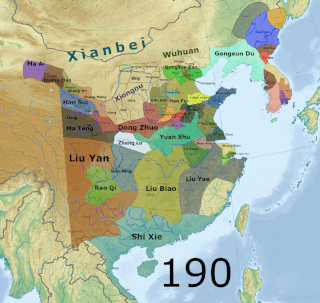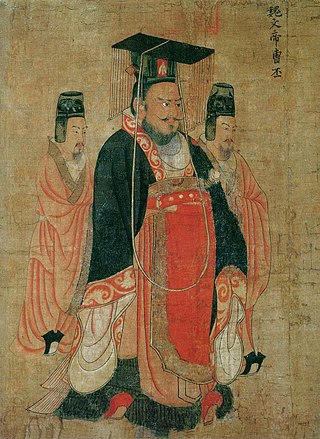
The 3rd century was the period from AD 201 (CCI) to AD 300 (CCC) in accordance with the Julian calendar.
The 190s decade ran from January 1, 190, to December 31, 199.
The 220s decade ran from January 1, 220, to December 31, 229.
The 230s decade ran from January 1, 230, to December 31, 239.

Year 233 (CCXXXIII) was a common year starting on Tuesday of the Julian calendar. At the time, it was known as the Year of the Consulship of Claudius and Paternus. The denomination 233 for this year has been used since the early medieval period, when the Anno Domini calendar era became the prevalent method in Europe for naming years.

The Three Kingdoms from 220 to 280 AD was the tripartite division of China among the dynastic states of Cao Wei, Shu Han, and Eastern Wu. The Three Kingdoms period was preceded by the Eastern Han dynasty and was followed by the Western Jin dynasty. The short-lived state of Yan on the Liaodong Peninsula, which lasted from 237 to 238, is sometimes considered as a "4th kingdom".
Year 264 (CCLXIV) was a leap year starting on Friday of the Julian calendar. At the time, it was known as the Year of the Consulship of Gallienus and Saturninus. The denomination 264 for this year has been used since the early medieval period, when the Anno Domini calendar era became the prevalent method in Europe for naming years.
Year 197 (CXCVII) was a common year starting on Saturday of the Julian calendar. At the time, it was known as the Year of the Consulship of Magius and Rufinus. The denomination 197 for this year has been used since the early medieval period, when the Anno Domini calendar era became the prevalent method in Europe for naming years.
Year 231 (CCXXXI) was a common year starting on Saturday of the Julian calendar. At the time, it was known as the Year of the Consulship of Claudius and Sallustus. The denomination 231 for this year has been used since the early medieval period, when the Anno Domini calendar era became the prevalent method in Europe for naming years.
Year 228 (CCXXVIII) was a leap year starting on Tuesday of the Julian calendar. At the time, it was known as the Year of the Consulship of Modestus and Maecius. The denomination 228 for this year has been used since the early medieval period, when the Anno Domini calendar era became the prevalent method in Europe for naming years.

Sun Quan, courtesy name Zhongmou (仲謀), posthumously known as Emperor Da of Wu, was the founder of the Eastern Wu dynasty, one of the Three Kingdoms of China. He inherited control of the warlord regime established by his elder brother, Sun Ce, in 200. He declared formal independence and ruled from November 222 to May 229 as the King of Wu and from May 229 to May 252 as the Emperor of Wu. Unlike his rivals Cao Cao and Liu Bei, Sun Quan was much younger than they were and governed his state mostly separate of politics and ideology. He is sometimes portrayed as neutral considering he adopted a flexible foreign policy between his two rivals with the goal of pursuing the greatest interests for the country.

Cao Pi, courtesy name Zihuan, was the first emperor of the state of Cao Wei in the Three Kingdoms period of China. He was the second son of Cao Cao, a warlord who lived in the late Eastern Han dynasty, but the eldest son among all the children born to Cao Cao by his concubine, Lady Bian. According to some historical records, he was often in the presence of court officials in order to gain their support. He was mostly in charge of defence at the start of his career. After the defeat of Cao Cao's rival Yuan Shao at the Battle of Guandu, he took Yuan Xi's widow, Lady Zhen, as a concubine, but in 221 Lady Zhen died and Guo Nüwang became empress.

Wei (220–266), known as Cao Wei or Former Wei in historiography, was a dynastic state of China and one of the three major states that competed for supremacy over China in the Three Kingdoms period. With its capital initially located at Xuchang, and thereafter Luoyang, the state was established by Cao Pi in 220, based upon the foundations laid by his father, Cao Cao, towards the end of the Eastern Han dynasty. The name "Wei" first became associated with Cao Cao when he was named the Duke of Wei by the Eastern Han government in 213, and became the name of the state when Cao Pi proclaimed himself emperor in 220. Historians often add the prefix "Cao" to distinguish it from other Chinese states known as "Wei". The authority of the ruling Cao family dramatically weakened in the aftermath of the deposing and execution of Cao Shuang and his siblings, the former being one of the regents for the third Cao Wei emperor, Cao Fang, with state authority gradually falling into the hands of Sima Yi, another Cao Wei regent, and his family, from 249 onwards. The last Wei emperors would remain largely as puppet rulers under the control of the Simas until Sima Yi's grandson, Sima Yan, forced the last Wei ruler, Cao Huan, to abdicate the throne and established the Western Jin dynasty.

Han (漢; 221–263), known in historiography as Shu Han (蜀漢 (listen)) or Ji Han (季漢 "Junior Han"), or often shortened to Shu (Chinese: 蜀; pinyin: Shŭ; Sichuanese Pinyin: Su2 < Middle Chinese: *źjowk < Eastern Han Chinese: *dźok), was a dynastic state of China and one of the three major states that competed for supremacy over China in the Three Kingdoms period. The state was based in the area around present-day Hanzhong, Sichuan, Chongqing, Yunnan, Guizhou, and north Guangxi, an area historically referred to as "Shu" based on the name of the past ancient kingdom of Shu, which also occupied this approximate geographical area. Its core territory also coincided with Liu Bang's Kingdom of Han, the precursor of the Han dynasty.

Wu, known in historiography as Eastern Wu or Sun Wu, was a dynastic state of China and one of the three major states that competed for supremacy over China in the Three Kingdoms period. It previously existed from 220 to 222 as a vassal kingdom nominally under Cao Wei, its rival state, but declared complete independence from Cao Wei in November 222. It was elevated to an empire in May 229 after its founding ruler, Sun Quan, declared himself emperor. Its name was derived from the place it was based in — the Jiangnan region, which was also historically known as "Wu". It was referred to as "Dong Wu" or "Sun Wu" by historians to distinguish it from other Chinese historical states with similar names which were also located in that region, such as the Wu state in the Spring and Autumn period and the Wuyue kingdom in the Five Dynasties and Ten Kingdoms period. It was called "Eastern Wu" because it occupied most of eastern China in the Three Kingdoms period, and "Sun Wu" because the family name of its rulers was "Sun". During its existence, Wu's capital was at Jianye, but at times it was also at Wuchang.
Gongsun Yuan, courtesy name Wenyi, was a Chinese military general, politician, and warlord who lived in the state of Cao Wei during the Three Kingdoms period of China. He rebelled against Wei in 237 and declared himself "King of Yan" (燕王). In 238, the Cao Wei general Sima Yi led forces to Liaodong and successfully conquered Yan.
Cao Rui, courtesy name Yuanzhong, was the second emperor of the state of Cao Wei during the Three Kingdoms period. His parentage is in dispute: his mother, Lady Zhen, was Yuan Xi's wife, but she later remarried Cao Pi, the first ruler of Wei. Based on conflicting accounts of his age, Pei Songzhi calculated that, in order to be Cao Pi's son, Cao Rui could not have been 33 when he died as recorded, so the recorded age was in error; late-Qing scholar Lu Bi and Mou Guangsheng argued instead that Cao Rui was Yuan Xi's son.
Cao Huan (245/246–302/303), courtesy name Jingming, was the fifth and last emperor of the state of Cao Wei during the Three Kingdoms period. On 4 February 266, he abdicated the throne in favour of Sima Yan, and brought an end to the Wei regime. After his abdication, Cao Huan was granted the title "Prince of Chenliu" and held it until his death, after which he was posthumously honoured as "Emperor Yuan ".
Lady Bian, also known as Empress Dowager Bian or Grand Empress Dowager Bian, formally known as Empress Wuxuan, was an empress dowager and later grand empress dowager of the state of Cao Wei during the Three Kingdoms period of China. She was the wife of Cao Cao, a warlord who rose to power in the late Eastern Han dynasty and laid the foundation of Wei. She bore Cao Cao's successor, Cao Pi, who ended the Han Dynasty and founded Wei in 220 after his father's death.
Sima Fu, courtesy name Shuda, was an imperial prince and statesman of the Jin dynasty of China. He previously served as an official in the state of Cao Wei during the Three Kingdoms period before his grandnephew, Sima Yan, usurped the Wei throne in 266 and established the Jin dynasty. Sima Guang, author of Zizhi Tongjian, claimed to be his descendant.






